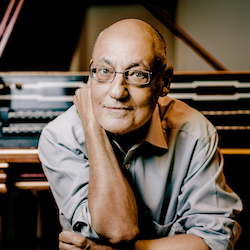
© Andrej Grilc
Andreas Staier
“Staier played the instrument with such a wealth of colors, so expressive, cantabile, sometimes profound, rumbling, or even introverted.”
The pianist Andreas Staier first became world famous as a harpsichordist. After studying with Lajos Rovatkay and Ton Koopman, he worked for three years with the Musica Antiqua Köln. But Staier is far more than a virtuoso representative of so-called historical performance practice. Rather, one could describe him as a passionate sound seeker. Each work that the pianist undertakes is not only analysed in terms of its structure, but also explores the historical situation in which it originated. Through his meticulous approach, he has opened up completely new interpretive approaches and made surprising listening experiences possible. This is why he also works with instrument makers to explore special nuances of sound—be it works of the 16th century such as the English virginalists, Bach’s Goldberg Variations, the Diabelli Variations of the late Beethoven, or the last piano works by Brahms. Staier has also always turned to lesser known composers when he could discover original aspects in their works, such as Sebastián de Albero and Josef Antonín Štěpán.
His commitment does not end with the music of the 19th century. This is shown by Staier’s collaboration with the French composer Brice Pauset (b. 1965) from whom several compositions have been commissioned. The Kontra Sonata (2000), a hybrid of Schubert’s Sonata in A minor, D. 845 and Pauset’s Kontrakompositionen is a prime example of Staier’s epoch-crossing musical thinking. Staier himself used the time during the Corona Pandemic to finish his composition Sechs Cembalostücke which he puts in connection with Bach’s Preludium and Fugue E Major of The Well-Tempered Clavier Book 2. The work was premiered at the Philharmonie in Cologne in January 2023, will be published by Editions Lemoine, and will be released by Outhere Music in 2024.
All this is documented on numerous recordings, almost all of which have received prestigious awards. Staier himself has often been honoured for his work. He was Artist in Residence at the AMUZ in Antwerp from 2012-2016, and between 2011 and 2021 at the Opéra de Dijon.
Whether at the harpsichord or the fortepiano, Staier performs at numerous renowned music festivals worldwide with ensembles such as the Freiburger Barockorchester, Concerto Köln, the Akademie für Alte Musik Berlin, and the Orquestra Barroca Casa da Música Porto with which he recorded À Portuguesa with works by Spanish composers for harmonia mundi in October 2018. For the Beethoven jubilee, Staier presented his album Ein neuer Weg—Beethoven, based on the three Op. 31 piano sonatas and the variations Opp. 34 and 35, which received rave reviews. His recording of the The Well-Tempered Clavier is considered a reference recording, and he has since released Book 1. Together with Roel Dieltiens he also released Beethoven’s Cello Sonatas, Op. 102 and the Bagatelles Opp. 119 and 126.
Longtime musical partners include the pianists Alexander Melnikov, Christine Schornsheim, and Tobias Koch, the violinists Isabelle Faust and Petra Müllejans, and the tenor Christoph Prégardien. Andreas Staier maintains a close collaboration with Daniel Sepec and the cellist Roel Dieltiens, with whom he has released an album of the Schubert piano trios amongst others.
Staier’s extensive interests and abilities have made him a much sought-after educator from an early age. In addition to masterclasses worldwide, he was Professor of Harpsichord and Fortepiano at the Schola Cantorum Basiliensis from 1987-1995. During the 2017/18 season, Andreas Staier was a Fellow at the Wissenschaftskolleg zu Berlin.
For several years, Andreas Staier also has been performing as a conductor and orchestra leader.

